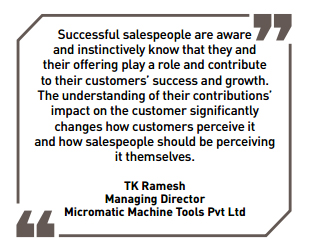BRIDGING THE PERCEPTION GAP

In B2B selling situations of machine tools that we encounter in our daily routine, it is supposedly impactful requirements like quality, productivity, flexibility that are being offered through measurable entities of size tolerance, surface finish, cycle time, speeds/feeds etc. This brings in measures and expectations of the product, performance and the known tangibles. What about the not directly measurable outcomes that are inherent and always present? What is actually valuable and what gets valued?
Getting the customer to spell out value and understanding his perceived value is an extremely critical process that must be in place and continuously honed as an organizational asset. This is a key skill that is a must for both sides of the coin. Another issue of the perceived value is that we need to understand the total value and how the value constituents add up, for example, size tolerance and cycle time, payment terms and delivery, Capex and cost of ownership etc. How do value constituents add up? It could even be an algebraic sum. Customers have issues that prevent them from spelling this out; it could be that they themselves are not clear or are plain worried to share. The way to go around these two issues are different, but both involve learning the understanding of each other and building trust from both sides.
 A robust question and answer session among the teams under the framework of ‘the ideal scenario’ is the most engaging methodology to achieve this. However, establishing the environment of mutual need and a purposeful connect is essential. Most impactful and breakthrough value creations have happened under these circumstances where the value systems of both customers and/or suppliers have been challenged. This is of course supported with data points, facts and references.
A robust question and answer session among the teams under the framework of ‘the ideal scenario’ is the most engaging methodology to achieve this. However, establishing the environment of mutual need and a purposeful connect is essential. Most impactful and breakthrough value creations have happened under these circumstances where the value systems of both customers and/or suppliers have been challenged. This is of course supported with data points, facts and references.
Successful salespeople are aware and instinctively know that they and their offering play a role and contribute to their customers’ success and growth. The understanding of the impact of their contributions on the customer significantly changes how customers perceive it and how salespeople should be perceiving it themselves. This understanding is greatly facilitated when the synergy between customer needs and the product/service solution offered is understood, well-crafted and genuine.
The views expressed by the author are personal and he can be contacted at rameshtkr@gmail.com



 Facebook
Facebook.png) Twitter
Twitter Linkedin
Linkedin Subscribe
Subscribe